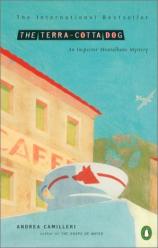Reading Group Guide
Discussion Questions
The Terra-Cotta Dog: The Inspector Montalbano Series #2

1. Inspector Montalbano's passion for food is a touchstone of his character. What, in your view, do the frequent descriptions of food contribute to this and, if you have read them, other Inspector Montalbano mysteries? Is it significant that Montalbano is so often shown eating, but so seldom preparing his own food?
2. Montalbano often uses questionable methods to achieve his goals, as when he uses blackmail photographs to intimidate Ingrid's father-in-law. Do Montalbano's ends always justify the means, or do you sometimes find his conduct unacceptable?
3. Alcide Maraventano suggests to Montalbano that life involves a vast system of diverse codes that people are always devising and deciphering. One such code is represented by the unlikely objects found near the mummified corpses of Lisetta and Mario. What kinds of messages can visual codes communicate that written words cannot? In what ways is The Terra-Cotta Dog a coded text?
4. In The Terra-Cotta Dog, Montalbano continues his vexed relationship with the press. Early in the novel, he barely makes it through his appearance at a press conference. Later in the book, however, he makes adroit use of the news media to prompt a key figure in the mystery to come forward. What has Montalbano learned about the manipulation of the media?
5. Typically, detective fiction starts with a crime and moves linearly toward the apprehension of the perpetrator. Andrea Camilleri's mysteries do not consistently follow this pattern. Rather, Camilleri uses the subgenre of the "police procedural" to engage thoughtfully in character development and to raise issues of moral ambiguity. How does Camilleri manage to resist some of the usual expectations of detective fiction while telling an engaging story?
6. In probing the mysteries of the Crasticeddru cave, Montalbano fears that he has desecrated both life and death. To feel that one has desecrated something, one must have a sense of the sacred. What, in the eyes of Inspector Montalbano, is sacred?
7. In The Terra-Cotta Dog, Montalbano is almost as frustrated by his law enforcement colleagues as he is bedeviled by the forces of the Sicilian underworld. How do the personality quirks and periodic incompetencies of the inspector's fellow officers contribute to the atmosphere of Camilleri's work?
8. Although Montalbano has rewarding friendships with women he respects intellectually, he routinely exasperates the women in his life who approach him with romantic intentions. How can it be that he is so comfortable with women on one level, but so ill at ease with them on another?
9. In the violent, corrupt milieu that is Vigàta, opportunities for redemption are scarce. If the possibility of redemption exists in The Terra-Cotta Dog, what are its sources? Despite its violence, is The Terra-Cotta Dog an essentially optimistic novel?
The Terra-Cotta Dog: The Inspector Montalbano Series #2
- Publication Date: March 25, 2003
- Mass Market Paperback: 352 pages
- Publisher: Penguin (Non-Classics)
- ISBN-10: 0142002631
- ISBN-13: 9780142002636







